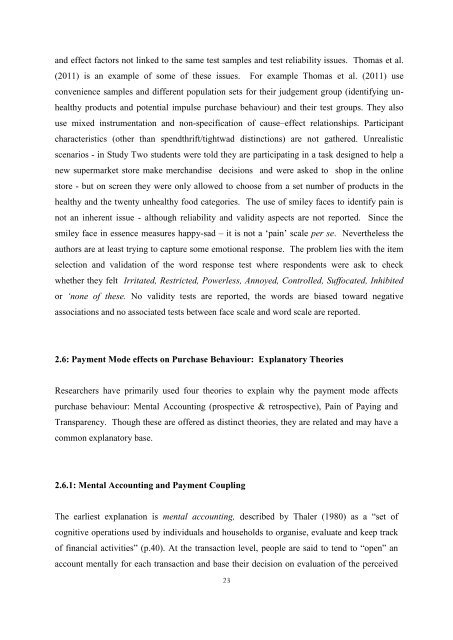Cash or Card: Consumer Perceptions of Payment Modes - Scholarly ...
Cash or Card: Consumer Perceptions of Payment Modes - Scholarly ...
Cash or Card: Consumer Perceptions of Payment Modes - Scholarly ...
You also want an ePaper? Increase the reach of your titles
YUMPU automatically turns print PDFs into web optimized ePapers that Google loves.
and effect fact<strong>or</strong>s not linked to the same test samples and test reliability issues. Thomas et al.<br />
(2011) is an example <strong>of</strong> some <strong>of</strong> these issues. F<strong>or</strong> example Thomas et al. (2011) use<br />
convenience samples and different population sets f<strong>or</strong> their judgement group (identifying un-<br />
healthy products and potential impulse purchase behaviour) and their test groups. They also<br />
use mixed instrumentation and non-specification <strong>of</strong> cause–effect relationships. Participant<br />
characteristics (other than spendthrift/tightwad distinctions) are not gathered. Unrealistic<br />
scenarios - in Study Two students were told they are participating in a task designed to help a<br />
new supermarket st<strong>or</strong>e make merchandise decisions and were asked to shop in the online<br />
st<strong>or</strong>e - but on screen they were only allowed to choose from a set number <strong>of</strong> products in the<br />
healthy and the twenty unhealthy food categ<strong>or</strong>ies. The use <strong>of</strong> smiley faces to identify pain is<br />
not an inherent issue - although reliability and validity aspects are not rep<strong>or</strong>ted. Since the<br />
smiley face in essence measures happy-sad – it is not a ‘pain’ scale per se. Nevertheless the<br />
auth<strong>or</strong>s are at least trying to capture some emotional response. The problem lies with the item<br />
selection and validation <strong>of</strong> the w<strong>or</strong>d response test where respondents were ask to check<br />
whether they felt Irritated, Restricted, Powerless, Annoyed, Controlled, Suffocated, Inhibited<br />
<strong>or</strong> ‘none <strong>of</strong> these. No validity tests are rep<strong>or</strong>ted, the w<strong>or</strong>ds are biased toward negative<br />
associations and no associated tests between face scale and w<strong>or</strong>d scale are rep<strong>or</strong>ted.<br />
2.6: <strong>Payment</strong> Mode effects on Purchase Behaviour: Explanat<strong>or</strong>y The<strong>or</strong>ies<br />
Researchers have primarily used four the<strong>or</strong>ies to explain why the payment mode affects<br />
purchase behaviour: Mental Accounting (prospective & retrospective), Pain <strong>of</strong> Paying and<br />
Transparency. Though these are <strong>of</strong>fered as distinct the<strong>or</strong>ies, they are related and may have a<br />
common explanat<strong>or</strong>y base.<br />
2.6.1: Mental Accounting and <strong>Payment</strong> Coupling<br />
The earliest explanation is mental accounting, described by Thaler (1980) as a “set <strong>of</strong><br />
cognitive operations used by individuals and households to <strong>or</strong>ganise, evaluate and keep track<br />
<strong>of</strong> financial activities” (p.40). At the transaction level, people are said to tend to “open” an<br />
account mentally f<strong>or</strong> each transaction and base their decision on evaluation <strong>of</strong> the perceived<br />
23

















